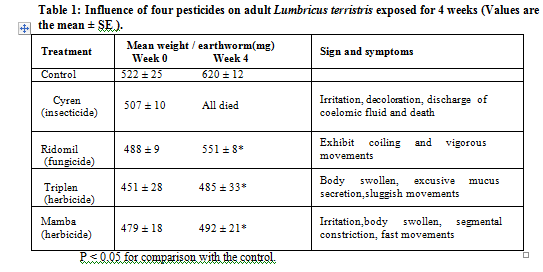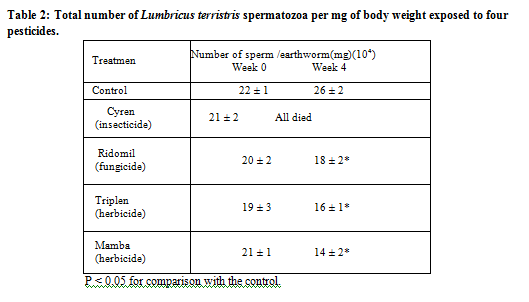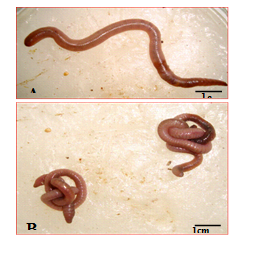IJCRR - 5(21), November, 2013
Pages: 01-05
Date of Publication: 21-Nov-2013
Print Article
Download XML Download PDF
THE IMPACT OF FOUR PESTICIDES ON THE EARTHWORM LUMBRICUS TERRESTRIS (ANNELIDA; OLIGOCHAETA)
Author: Sherwan Taeeb Ahmed
Category: General Sciences
Abstract:The influence of four pesticides (Cyren, Ridomil, Triplen and Mamba) on Lumbricus terrestris earthworm for 4 weeks was studied in the laboratory. Results indicate that there are loss of weight in all cultures, signs and symptoms of toxicity such as coiling, selling of the body swollen, sluggish movements and discharge of coelomic fluid. Significant decrease in total sperm numbers was observed at the end of study period. The present study indicates that among the four pesticides tested Cyren is the most toxic to earthworm Lumbricus terristris causing high mortality, while Triplen and Mamba are moderately toxic and Ridomil was the least toxic pesticide.
Keywords: Toxicity, Lumbricus, weight, sperm.
Full Text:
INTRODUCTION
Earthworms are more important organisms of the soil invertebrate fauna, they are considered as ecosystem engineers as they produce pronounced effects on soil structure due to their burrowing activities, ingestion of soil and production of castings (Latif et al., 2009). Pesticides, that are applied in agriculture ?elds, may affect the non-target soil organisms including earthworms and signi?cantly damage the ecosystem (Lavelle and Spain 2002). Pesticides, are either directly applied to soil to control soil borne pests or are deposited on soil as run off from foliar applications. Whatever the source, earthworms are exposed to pesticides through (a) skin contact and (b) by feeding on contaminated litter in soil. The effect of pesticides on earthworm may be either due to soil/foliar application at high concentrations or slow accumulation of low levels of persistent pesticide residues (Edwards 1990; Correia and Moreira 2010).
Since earthworms are preferred as food by amphibians, reptiles, birds and mammals there is a possible risk of these pesticides reaching higher trophic levels (Marino et al. 1992). Several researchers have advocated the use of earthworms as ecotoxicological model for risk assessment and bioassay of pesticides ( Edwards and Bohlen 1992; Cikutovic, et al. 2010).
In the present study experiments were made to evaluate the effects of four pesticides on the night crowling earthworm Lumbricus terrestris. This species is widely distributed in the Kurdistan region of Iraq and is considered as an ecologically important soil organism for its role in increasing soil fertility and for its potential of being used in the production of vermicompost (Nassri 1989). The pesticides tested in the present study include two herbicides (Mamba and Triplen), one insecticide (Cyren) and one fungicide (Ridomil).
MATERIALS AND METHODS
During February and April 2011, adult Lumbricus terristris worms were obtained from three local gardens in Erbil city (Kurdistan, Iraq) that have never been used for any agricultural purpose and pest control. The specimens were brought to the
laboratory and were cultured in small earthen pots (1liter containers). Finely grinded soil (collected from the same gardens) and a dry mass mixture of organic potting mixed in the ratio of 4:1 were used as the culture medium (Ismail 1997). The cultured earthworms were acclimated to laboratory conditions for 72 hrs and maintained at ≤ eight worms/liter, moistened with 200-220 ml distilled deionized water/kg in an environmental chamber set at 25-30°C. 65-70% moisture was maintained by adding nonchlorinated water into the medium. The culture pots were covered with ?ne meshed cloth nets (Reinecke and Reinecke 2007) .
The recommended doses of the four pesticides [1-Cyren (insecticide): Chlorpyriphos 500 g/l, Cypermethrin 50 g/l, 2 - Ridomil (fungicide): Mefenoxam 4 g/l, Mancozeb 64 g/l, 3 - Triplen (herbicide): Trifluralin 480 g/l, 4 – Mamba (herbicide): Glycophosate: 480 g/l ] (which are used by local farmers as pest control) were administered in to the test cultures by spraying overeach of the containers for one time only. The experiment was set up with two replicates for each pesticide and control and then incubated in their chamber. Observations were made every 24 hrs, those individuals who showed no response to apparent sign of life , even when poked with a needle, were considered dead and were removed (Yasamin and Dsouza 2010).
Animals were placed in ethanol solution (5%) and dissected to extract the male reproductive organs, located between the prostomium and the clitellum. Seminal vesicles were separated and placed in Petri dishes containing 1 ml of PBS (pH 7.4) and cut in small pieces to allow the liberation of the spermatozoa and perform sperm counts using a Neubauer chamber. Counts were expressed as number of spermatozoa per animal (Espinoza and Bustos 2004).
The pesticides used in present study along with source of obtaining and recommended agricultural doses were supplied by Agricultural Research Center/ Ministry of Agriculture and Water Resources-Erbil/Iraq
Statistics: Earthworm weight and sperm count were analysed over time using Analysis of Variance (ANOVA) and means separated using Duncan’s Multiple Range Test at p≤0.05 (SPSS, Windows 11.5).
RESULTS
The data presented in Table 1 clearly show that earthworm weight was significantly reduced by exposure to the four pesticides and, after 4 weeks exposure earthworm weight differed from the control in all treatments, There was a remarkable loss of weight in all cultures with noting that all individuals which were treated with Cyren (insecticide) died after three days post treatment.
The animals showed progressive signs and symptoms of toxicity ranging from visibly undetectable marks to coiling (Figure 1), curling, extrusion of coelomic fluid, segmental constriction and swelling. In several animals the swollen portion burst causing bloody lesions, limp and ultimately death (Table 1).
During the 4-week period of the test the results also showed that the number of sperms were reduced significantly at the end of the study period in all treatments as presented in Table 2.
DISCUSSION
The symptoms produced after exposure of L. terrstris to pesticide were specific in nature and so may help in recognizing the pesticide, e.g. coiling , curling (Ridomil), mucus secretion, sluggish movements (Triplen), lifting of the body, extrusion of coelomic fluid (Cyren), globular swelling, segmental constriction, white band (Mamba) (Chakravorty and Kaviraj 2010).
Many investigators have reported a high toxicity of Chlorpyrifos and Cypermethrin insecticides on many species of earthworms in different countries, the effects ranging between moderate mortality to Perionyx exacavtus (Chakravorty and Kaviraj 2010) and decrease in body weight of Eisenia
fetido (Yasamin and Dsouza 2010). Booth et al. 2000 observed loss of weight of Aporrectodea caliginosa when treated with organophosphate pesticides in field and laboratory also. (Faheem and Farhanullah Khan 2010) reported that predictable signs and symptoms of Imidacloprid poisoning on Pheretima posthuma including tiredness, twitching, cramps, and muscle weakness also including the muscles essential for breathing. Data presented in the study by Farrukh and Ali 2011 clearly showed that dichlorovos caused a decrease in the weight of all groups of earthworms, when they were exposed to different concentrations of dichlorovos fumigant insecticide.
This study showed that there was a significant decrease in sperm numbers of animals treated with the four pesticides, Sophie et al. (1995) showed that dieldrin at relatively low concentrations caused structural damage, especially to the nucleus of the sperm which may cause several changes in morphology, motility, and sperm density.
A significant decrease in sperm numbers were found at 15 and 30 days in the dose of 600 mg of malathion for kg of soil (Espinoza and Bustos 2004). This decrease of the sperm count indicates that the insecticide has been degraded to its active metabolites malaoxon and isomalathion, which could also alter spermatogenesis (ATSDR 2000). In another study when three different concentrations of benomyl were applied for one week there were abnormalities in the ultrastructure of the spermatogonia, spermatids, and spermatozoa of the earthworm Eisenia fetid (Sorour and Larink 2001). Xiao et al. (2006) mentioned that sperm count of the earthworm E. fetida depended on the duration and concentration of acetochlor (herbicide) exposure. After 5 days of exposure, number of sperm per mg of body did not change significantly when earthworms were treated with different concentrations of acetochlor. Low and middle concentrations showed higher sperm count. After 15 days of exposure, sperm count decreased when earthworms were treated with increasing concentration of acetochlor.
CONCLUSION
Based on the observations of the present study and previous studies, it can be concluded that the growth and reproductive parameters of earthworms exposed to pesticides seem to be useful bioindicators of soil pollution. Research should be extended to ecologically relevant species of earthworms, and also to other soil fauna to get a comprehensive knowledge on the malfunction in the soil biological processes due to pesticide pollution. Numerous studies indicate negative impact of pesticides on earthworm growth and reproduction. So, there is a need to acquire more knowledge on the chemical nature, mode of action, and means of degradation of pesticides in soil.
ACKNOWLEDGMENT
The author would like to express sincere appreciation to Miss Shelan for providing the pesticides and Department of biology, Collage of Science, University of Salahaddin / Erbil for their financial support.



References:
- ATSDR (Agency for Toxic Substances and Disease Registry),eds. Malathion; Resumen técnico químico para profesionales de la Salud Pública. Atlanta, Georgia. U.S.A., 2000.
- Booth LH, Heppel VJ, Halloran K. Growth, Development and Fecundity of The Earthworm Aporrectodea Caliginosa After Exposure to Two Organophosphates. New- zealand Plant Protection 2000; 53: 221-225.
- Chakravorty RD, Kaviraj A. Studies on Relative Toxicities of Six Insecticides on Epigeic Earthworm, Perionyx exacavatus. Bulletin of Environental Contamination and Toxicology 2010; 85 : 83-86.
- Cikutovic MA, Fitzpatrick LC, Venables BS, Goven A J. Sperm count in earthworms as a biomarker for environmental toxicology: Effect of cadmium and chlordane, Environmental pollution 2010; 81(2): 123-125.
- Correia FV, Moreira JC. Effect of glyphosate and 2,4-D on earthworms Eisenia foetida, Bulletin of Environental Contamination and Toxicology 2010; 85(3): 264-8.
- Edwards CA, Bohlen P J. The effects of toxic chemicals on earthworms. Review of Environental Contamination and Toxicoogyl 1992; 125: 23-99.
- Edwards CA. The impact of insecticides on soil ecosystem criterion. Review of Plant Science 1990; 8:145-171.
- Espinoza NO, Bustos OE. Sublethal doses of malathion alter male reproductive parameters of Eisenia foetida. Inernational Journal of Morphology 2004; 22(4): 297-302.
- Farrukh S, Ali AS. Effects of Dichlorovos Organophosphate on Growth, Reproduction,and Avoidance Behavior of Earthworm Eisenia foetida. Iranian Journal of Toxicology 2011; 5(14): 495-501.
- Ismail SA. Vermicology - the biology of earthworms. Orient Longman 1997; p. 90
- Latif R, Ezzatpanah S, Malik M, Parsa H. Earthworms of the Central Elburz Mountains, Iran. Iranian Journal of Animal Biosystematics 2009; 5(2):1-5.
- Lavelle P, Spain AV. Soil ecology. Kluwer, Dordrecht 2002.
- Marino F, Ligero A, Cosin DJ. Heavy metals and earthworms on the border of a road next to Santiago. Soil Biology and Biochemistry 1992; 24: 1705-1709.
- Nassri NH. Effect of Some Pollutants on earthworm Lumbricus terristris (Annelida;Oligochaeta) MSc Thesis.University of Salahaddin/Iraq, 1989.
- Reinecke SA, Reinecke AJ. The impact of organophosphate pesticides in orchards on earthworms in the Western Cape, South Africa. Ecotoxicology and Environmental Safety 2007; 66: 244-251.
- Sophiè AR, Adriaan JR, Moya LF. The effects of dieldrin on the sperm ultrastructure of the earthworm Eudrilus eugeniae (Oligochaeta). Environmental Toxicology 1995; 14: (6):961-965.
- Sorour J, and Larink O. Toxic effects of Benomyl on the ultrastructure during Spermatogenesis of the earthworm Eisenia fetida. Ecotoxicology and Environmental Safety 2001;50(3):180-188.
- Yasamin S, Dsouza D. Effects of Pesticides on the Growth and Reproduction of Earthworm: A Review. Applied and Environmental Soil Science 2010; 9 pages.
- Xiao NW, SongY, Ge F, Liu XH, Ou-Yang ZY. Biomarkers responses of the earthworm Eisenia fetida to acetochlor exposure in OECD soil .Chemosphere 2006; 65:907-912
|






 This work is licensed under a Creative Commons Attribution-NonCommercial 4.0 International License
This work is licensed under a Creative Commons Attribution-NonCommercial 4.0 International License